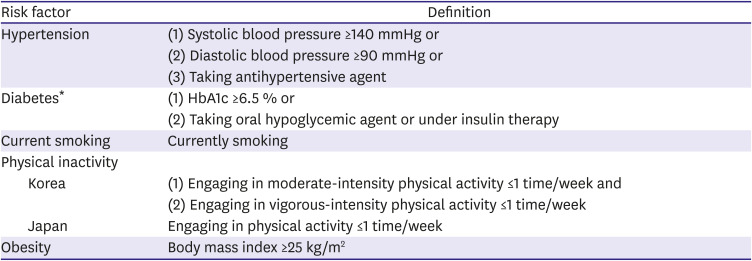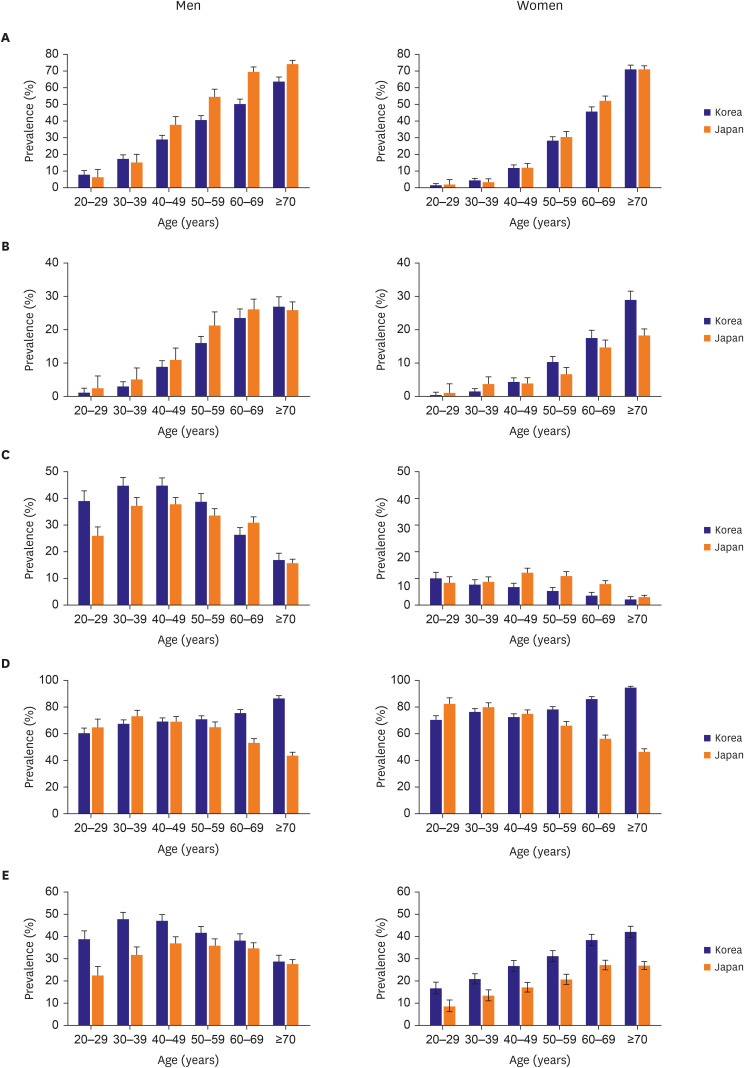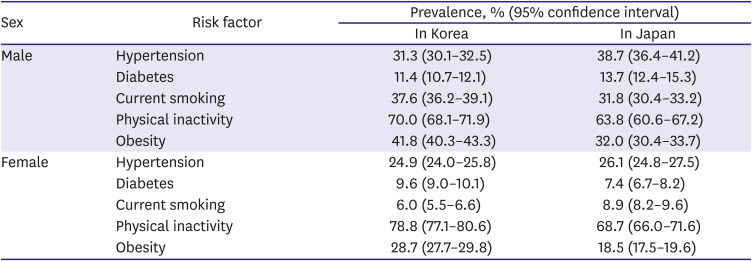1. GBD 2017 Causes of Death Collaborators. Global, regional, and national age-sex-specific mortality for 282 causes of death in 195 countries and territories, 1980–2017: a systematic analysis for the Global Burden of Disease Study 2017. Lancet. 2018; 392:1736–1788. PMID:
30496103.
2. Roth GA, Mensah GA, Johnson CO, et al. Global burden of cardiovascular diseases and risk factors, 1990–2019: update from the GBD 2019 study. J Am Coll Cardiol. 2020; 76:2982–3021. PMID:
33309175.
3. Lee HH, Cho SMJ, Lee H, et al. Korea heart disease fact sheet 2020: analysis of nationwide data. Korean Circ J. 2021; 51:495–503. PMID:
34085422.

4. Baek J, Lee H, Lee HH, Heo JE, Cho SMJ, Kim HC. Thirty-six year trends in mortality from diseases of circulatory system in Korea. Korean Circ J. 2021; 51:320–332. PMID:
33821581.

5. Hata J, Ninomiya T, Hirakawa Y, et al. Secular trends in cardiovascular disease and its risk factors in Japanese: half-century data from the Hisayama study (1961–2009). Circulation. 2013; 128:1198–1205. PMID:
23902756.
6. Jang IY, Lee HY, Lee E. 50th Anniversary Committee of Korean Geriatrics Society. Geriatrics fact sheet in Korea 2018 from national statistics. Ann Geriatr Med Res. 2019; 23:50–53. PMID:
32743288.

7. Nakatani H. Population aging in Japan: policy transformation, sustainable development goals, universal health coverage, and social determinates of health. Glob Health Med. 2019; 1:3–10. PMID:
33330747.

8. Stewart J, Manmathan G, Wilkinson P. Primary prevention of cardiovascular disease: A review of contemporary guidance and literature. JRSM Cardiovasc Dis. 2017; 6:2048004016687211. PMID:
28286646.

9. Lloyd-Jones DM, Hong Y, Labarthe D, et al. Defining and setting national goals for cardiovascular health promotion and disease reduction: the American Heart Association's strategic Impact Goal through 2020 and beyond. Circulation. 2010; 121:586–613. PMID:
20089546.
10. Mensah GA, Wei GS, Sorlie PD, et al. Decline in cardiovascular mortality: possible causes and implications. Circ Res. 2017; 120:366–380. PMID:
28104770.
11. Lee HY, Shin J, Kim GH, et al. 2018 Korean Society of Hypertension guidelines for the management of hypertension: part II-diagnosis and treatment of hypertension. Clin Hypertens. 2019; 25:20. PMID:
31388453.

12. Umemura S, Arima H, Arima S, et al. The Japanese Society of Hypertension guidelines for the management of hypertension (JSH 2019). Hypertens Res. 2019; 42:1235–1481. PMID:
31375757.
14. Kim HC, Cho SMJ, Lee H, et al. Korea hypertension fact sheet 2020: analysis of nationwide population-based data. Clin Hypertens. 2021; 27:8. PMID:
33715619.

15. Fuchs FD, Whelton PK. High blood pressure and cardiovascular disease. Hypertension. 2020; 75:285–292. PMID:
31865786.

16. Ueshima H, Sekikawa A, Miura K, et al. Cardiovascular disease and risk factors in Asia: a selected review. Circulation. 2008; 118:2702–2709. PMID:
19106393.
17. Soenarta AA, Buranakitjaroen P, Chia YC, et al. An overview of hypertension and cardiac involvement in Asia: focus on heart failure. J Clin Hypertens (Greenwich). 2020; 22:423–430. PMID:
31955506.

18. Oh HJ, Lee S, Lee EK, et al. Association of blood pressure components with mortality and cardiovascular events in prehypertensive individuals: a nationwide population-based cohort study. Ann Med. 2018; 50:443–452. PMID:
29929398.

19. Lida M, Ueda K, Okayama A, et al. Impact of elevated blood pressure on mortality from all causes, cardiovascular diseases, heart disease and stroke among Japanese: 14 year follow-up of randomly selected population from Japanese -- Nippon data 80. J Hum Hypertens. 2003; 17:851–857. PMID:
14704729.

20. Jung HH. Association of optimal blood pressure with critical cardiorenal events and mortality in high-risk and low-risk patients treated with antihypertension medications. JAMA Netw Open. 2019; 2:e199307. PMID:
31441935.

21. Lee CJ, Ryu J, Kim HC, et al. Clinical benefit of treatment of stage-1, low-risk hypertension. Hypertension. 2018; 72:1285–1293. PMID:
30571236.

22. Ikeda A, Iso H, Yamagishi K, Inoue M, Tsugane S. Blood pressure and the risk of stroke, cardiovascular disease, and all-cause mortality among Japanese: the JPHC study. Am J Hypertens. 2009; 22:273–280. PMID:
19229210.

23. Kim MK, Ko SH, Kim BY, et al. 2019 Clinical practice guidelines for type 2 diabetes mellitus in Korea. Diabetes Metab J. 2019; 43:398–406. PMID:
31441247.

24. Araki E, Goto A, Kondo T, et al. Japanese clinical practice guideline for diabetes 2019. J Diabetes Investig. 2020; 11:1020–1076.

25. International Diabetes Federation. IDF Diabetes Atlas. 9th ed. Brussels: International Diabetes Federation;2019.
26. De Rosa S, Arcidiacono B, Chiefari E, Brunetti A, Indolfi C, Foti DP. Type 2 diabetes mellitus and cardiovascular disease: genetic and epigenetic links. Front Endocrinol (Lausanne). 2018; 9:2. PMID:
29387042.

27. Aambø A, Klemsdal TO. Cardiovascular disease and diabetes in patients with African or Asian background. Tidsskr Nor Laegeforen. 2017; 137.
28. Kim HK, Lee JB, Kim SH, et al. Association of prediabetes, defined by fasting glucose, HbA1c only, or combined criteria, with the risk of cardiovascular disease in Koreans. J Diabetes. 2016; 8:657–666. PMID:
26355268.

29. Bae JC, Cho NH, Suh S, et al. Cardiovascular disease incidence, mortality and case fatality related to diabetes and metabolic syndrome: a community-based prospective study (Ansung-Ansan cohort 2001–12). J Diabetes. 2015; 7:791–799. PMID:
25407754.

30. Hayama-Terada M, Muraki I, Imano H, et al. Diabetes trend and impact on risk of cardiovascular disease in middle-aged Japanese people - the CIRCS study. Circ J. 2016; 80:2343–2348. PMID:
27666757.
31. Saito I, Kokubo Y, Yamagishi K, Iso H, Inoue M, Tsugane S. Diabetes and the risk of coronary heart disease in the general Japanese population: the Japan Public Health Center-based prospective (JPHC) study. Atherosclerosis. 2011; 216:187–191. PMID:
21300356.

32. Cui R, Iso H, Yamagishi K, et al. Diabetes mellitus and risk of stroke and its subtypes among Japanese: the Japan Public Health Center study. Stroke. 2011; 42:2611–2614. PMID:
21836098.
33. Rhee EJ, Kim HC, Kim JH, et al. 2018 Guidelines for the management of dyslipidemia in Korea. J Lipid Atheroscler. 2019; 8:78–131. PMID:
32821702.

34. Kinoshita M, Yokote K, Arai H, et al. Japan Atherosclerosis Society (JAS) guidelines for prevention of atherosclerotic cardiovascular diseases 2017. J Atheroscler Thromb. 2018; 25:846–984. PMID:
30135334.

37. Stein R, Ferrari F, Scolari F. Genetics, dyslipidemia, and cardiovascular disease: new insights. Curr Cardiol Rep. 2019; 21:68. PMID:
31227920.

38. Lee H, Park JB, Hwang IC, et al. Association of four lipid components with mortality, myocardial infarction, and stroke in statin-naïve young adults: a nationwide cohort study. Eur J Prev Cardiol. 2020; 27:870–881. PMID:
32013600.

39. Okamura T, Tanaka H, Miyamatsu N, et al. The relationship between serum total cholesterol and all-cause or cause-specific mortality in a 17.3-year study of a Japanese cohort. Atherosclerosis. 2007; 190:216–223. PMID:
16529754.

40. World Health Organization. WHO global report on trends in prevalence of tobacco smoking 2000–2025. 2nd ed. Geneva: World Health Organization;2018.
41. Yusuf S, Hawken S, Ounpuu S, et al. Effect of potentially modifiable risk factors associated with myocardial infarction in 52 countries (the INTERHEART study): case-control study. Lancet. 2004; 364:937–952. PMID:
15364185.

42. Baba S, Iso H, Mannami T, et al. Cigarette smoking and risk of coronary heart disease incidence among middle-aged Japanese men and women: the JPHC study Cohort I. Eur J Cardiovasc Prev Rehabil. 2006; 13:207–213. PMID:
16575274.

43. Honjo K, Iso H, Tsugane S, et al. The effects of smoking and smoking cessation on mortality from cardiovascular disease among Japanese: pooled analysis of three large-scale cohort studies in Japan. Tob Control. 2010; 19:50–57. PMID:
20008160.

45. An KY. Physical activity level in Korean adults: the Korea National Health and Nutrition Examination Survey 2017. Epidemiol Health. 2019; 41:e2019047. PMID:
31801321.

46. Chen T, Kishimoto H, Honda T, et al. Patterns and levels of sedentary behavior and physical activity in a general Japanese population: the Hisayama study. J Epidemiol. 2018; 28:260–265. PMID:
29176275.

47. Li J, Siegrist J. Physical activity and risk of cardiovascular disease--a meta-analysis of prospective cohort studies. Int J Environ Res Public Health. 2012; 9:391–407. PMID:
22470299.

48. Jeong SW, Kim SH, Kang SH, et al. Mortality reduction with physical activity in patients with and without cardiovascular disease. Eur Heart J. 2019; 40:3547–3555. PMID:
31504416.

49. Kubota Y, Iso H, Yamagishi K, Sawada N, Tsugane S. JPHC Study Group (Japan Public Health Center). Daily total physical activity and incident cardiovascular disease in Japanese men and women: Japan Public Health Center-based prospective study. Circulation. 2017; 135:1471–1473. PMID:
28396381.
50. Noda H, Iso H, Toyoshima H, et al. Walking and sports participation and mortality from coronary heart disease and stroke. J Am Coll Cardiol. 2005; 46:1761–1767. PMID:
16256882.

52. Seo MH, Lee WY, Kim SS, et al. 2018 Korean Society for the study of obesity guideline for the management of obesity in Korea. J Obes Metab Syndr. 2019; 28:40–45. PMID:
31089578.

53. Examination Committee of Criteria for 'Obesity Disease' in Japan. Japan Society for the Study of Obesity. New criteria for ‘obesity disease’ in Japan. Circ J. 2002; 66:987–992. PMID:
12419927.
54. Seo MH, Kim YH, Han K, et al. Prevalence of obesity and incidence of obesity-related comorbidities in Koreans based on National Health Insurance Service Health Checkup data 2006–2015. J Obes Metab Syndr. 2018; 27:46–52. PMID:
31089540.
55. Yoshiike N, Miyoshi M. Epidemiological aspects of overweight and obesity in Japan--international comparisons. Nihon Rinsho. 2013; 71:207–216. PMID:
23631195.
56. Cercato C, Fonseca FA. Cardiovascular risk and obesity. Diabetol Metab Syndr. 2019; 11:74. PMID:
31467596.

57. Shin J, Ham D, Shin S, Choi SK, Paik HY, Joung H. Effects of lifestyle-related factors on ischemic heart disease according to body mass index and fasting blood glucose levels in Korean adults. PLoS One. 2019; 14:e0216534. PMID:
31091295.

58. Choi S, Kim K, Kim SM, et al. Association of obesity or weight change with coronary heart disease among young adults in South Korea. JAMA Intern Med. 2018; 178:1060–1068. PMID:
29913019.

59. Li Y, Yatsuya H, Iso H, et al. Body mass index and risks of incident ischemic stroke subtypes: the Japan Public Health Center-based prospective (JPHC) study. J Epidemiol. 2019; 29:325–333. PMID:
30555115.

60. Zheng W, McLerran DF, Rolland B, et al. Association between body-mass index and risk of death in more than 1 million Asians. N Engl J Med. 2011; 364:719–729. PMID:
21345101.
61. Hozawa A, Okamura T, Oki I, et al. Relationship between BMI and all-cause mortality in Japan: NIPPON DATA80. Obesity (Silver Spring). 2008; 16:1714–1717. PMID:
18421264.

62. Saito I, Konishi M, Iso H, Inoue M, Tsugane S. Impact of weight change on specific-cause mortality among middle-aged Japanese individuals. J Epidemiol Community Health. 2009; 63:447–454. PMID:
19221112.

63. Anand SS, Hawkes C, de Souza RJ, et al. Food consumption and its impact on cardiovascular disease: importance of solutions focused on the globalized food system: a report from the workshop convened by the World Heart Federation. J Am Coll Cardiol. 2015; 66:1590–1614. PMID:
26429085.
64. Koyama T, Yoshita K, Okuda N, et al. Overall nutrient and total fat intake among Japanese people: the INTERLIPID study Japan. Asia Pac J Clin Nutr. 2017; 26:837–848. PMID:
28802293.
65. Raatz SK, Silverstein JT, Jahns L, Picklo MJ Sr. Issues of fish consumption for cardiovascular disease risk reduction. Nutrients. 2013; 5:1081–1097. PMID:
23538940.
66. Wang YJ, Yeh TL, Shih MC, Tu YK, Chien KL. Dietary sodium intake and risk of cardiovascular disease: a systematic review and dose-response meta-analysis. Nutrients. 2020; 12:12.

67. Son J, Lee Y, Park K. Effects of processed red meat consumption on the risk of type 2 diabetes and cardiovascular diseases among Korean adults: the Korean Genome and Epidemiology Study. Eur J Nutr. 2019; 58:2477–2484. PMID:
30069618.

68. Nagao M, Iso H, Yamagishi K, Date C, Tamakoshi A. Meat consumption in relation to mortality from cardiovascular disease among Japanese men and women. Eur J Clin Nutr. 2012; 66:687–693. PMID:
22333876.

69. Eshak ES, Iso H, Date C, et al. Rice intake is associated with reduced risk of mortality from cardiovascular disease in Japanese men but not women. J Nutr. 2011; 141:595–602. PMID:
21346103.
70. Eshak ES, Iso H, Yamagishi K, et al. Rice consumption is not associated with risk of cardiovascular disease morbidity or mortality in Japanese men and women: a large population-based, prospective cohort study. Am J Clin Nutr. 2014; 100:199–207. PMID:
24740204.

71. Park JE, Ryu Y, Cho SI. The effect of reference group classification and change in alcohol consumption on the association between alcohol consumption and cardiovascular disease. Alcohol Clin Exp Res. 2017; 41:379–387. PMID:
28098956.

72. Lin Y, Kikuchi S, Tamakoshi A, et al. Alcohol consumption and mortality among middle-aged and elderly Japanese men and women. Ann Epidemiol. 2005; 15:590–597. PMID:
16118003.

73. Iso H, Kobayashi M, Ishihara J, et al. Intake of fish and n3 fatty acids and risk of coronary heart disease among Japanese: the Japan Public Health Center-based (JPHC) study cohort I. Circulation. 2006; 113:195–202. PMID:
16401768.
74. Yamagishi K, Iso H, Date C, et al. Fish, omega-3 polyunsaturated fatty acids, and mortality from cardiovascular diseases in a nationwide community-based cohort of Japanese men and women the JACC (Japan Collaborative Cohort Study for Evaluation of Cancer Risk) study. J Am Coll Cardiol. 2008; 52:988–996. PMID:
18786479.
75. Park Y, Park S, Yi H, et al. Low level of n-3 polyunsaturated fatty acids in erythrocytes is a risk factor for both acute ischemic and hemorrhagic stroke in Koreans. Nutr Res. 2009; 29:825–830. PMID:
19963154.

76. Choi-Kwon S, Kim JS. Lifestyle factors and risk of stroke in Seoul, south Korea. J Stroke Cerebrovasc Dis. 1998; 7:414–420. PMID:
17895120.

77. Lim H, Choue R. Dietary pattern, nutritional density, and dietary quality were low in patients with cerebral infarction in Korea. Nutr Res. 2011; 31:601–607. PMID:
21925345.

78. Takachi R, Inoue M, Shimazu T, et al. Consumption of sodium and salted foods in relation to cancer and cardiovascular disease: the Japan Public Health Center-based prospective study. Am J Clin Nutr. 2010; 91:456–464. PMID:
20016010.
79. Nakamura Y, Ueshima H, Okamura T, et al. A Japanese diet and 19-year mortality: national integrated project for prospective observation of non-communicable diseases and its trends in the aged, 1980. Br J Nutr. 2009; 101:1696–1705. PMID:
19021919.

80. Shima A, Miyamatsu N, Miura K, et al. Relationship of household salt intake level with long-term all-cause and cardiovascular disease mortality in Japan: NIPPON DATA80. Hypertens Res. 2020; 43:132–139. PMID:
31748704.

81. Umesawa M, Iso H, Date C, et al. Relations between dietary sodium and potassium intakes and mortality from cardiovascular disease: the Japan Collaborative Cohort Study for Evaluation of Cancer Risks. Am J Clin Nutr. 2008; 88:195–202. PMID:
18614741.

82. Ikehara S, Iso H, Date C, et al. Salt preference and mortality from stroke and coronary heart disease for Japanese men and women: the JACC study. Prev Med. 2012; 54:32–37. PMID:
22057056.

83. Kweon S, Kim Y, Jang MJ, et al. Data resource profile: the Korea National Health and Nutrition Examination Survey (KNHANES). Int J Epidemiol. 2014; 43:69–77. PMID:
24585853.

84. Ikeda N, Takimoto H, Imai S, Miyachi M, Nishi N. Data resource profile: the Japan National Health and Nutrition Survey (NHNS). Int J Epidemiol. 2015; 44:1842–1849. PMID:
26239276.








 PDF
PDF Citation
Citation Print
Print



 XML Download
XML Download